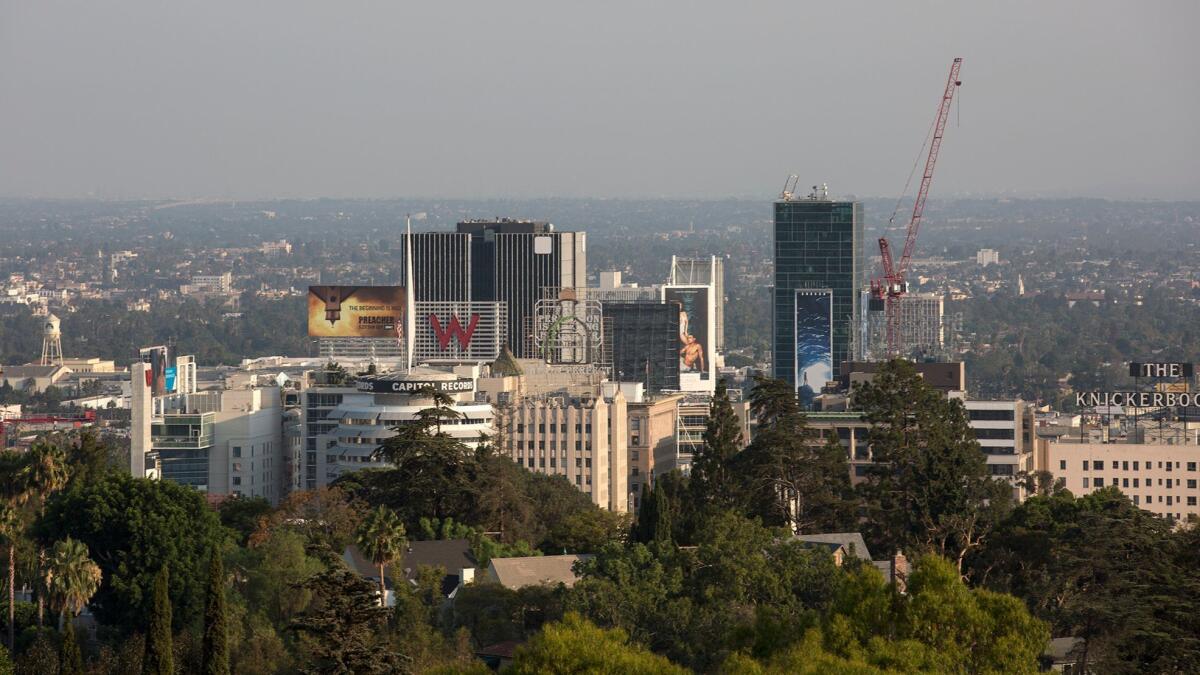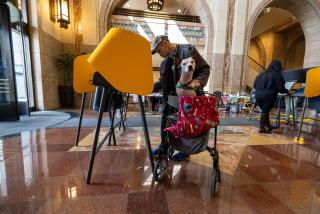Making sense of Measure S, the latest battle in L.A.’s long war over development

- Share via
If you want to understand the forces — and more to the point, the grievances — that gave rise to Measure S, the anti-development initiative that will appear on the March 7 ballot in Los Angeles, you have to go back to the 1980s. That was the decade Angelenos finally rebelled in significant numbers against the headlong growth that had defined the city since the tail end of the 19th century.
That backlash began as early as the 1960s; Richard Lillard’s book “Eden in Jeopardy,” published in 1966, lamented a Los Angeles that in “rushing from one brilliant improvisation to another, valuing means, neglecting ends” had become a city that reflexively favored “the politically expedient” over “the historic past.”
As a relentless pace of construction and expansion continued, with apartment buildings crowding out single-family houses on residential blocks and new office towers popping up on formerly low- or mid-rise boulevards, especially on the Westside, even some champions of growth decided they’d had enough.
Anti-development activists crowned their efforts with Proposition U, which appeared on the ballot in November 1986 and called for significantly reducing the size and height of new buildings across a wide swath of the city — a process urban planners call “down-zoning.” The Times, in an editorial, came out against it; the same week the paper’s op-ed page published a defense of the measure by Barbara S. Blinderman, a land-use attorney, and Laura M. Lake, an adjunct professor at UCLA, founders of a slow-growth group called Not Yet New York.
Prop. U passed by a wide margin. Its caps on development — which were originally aimed at commercial projects but have over time restricted the production of housing as well — remain in effect. Others have been added over the years in the form of historic preservation overlay zones — HPOZs — and other restrictions on what can be built where.
According to one recent study, the housing stock in the L.A. metro area grew by only 20% between 1980 and 2010, compared with 54% in the typical U.S. metro area. To keep home prices from rising faster in L.A. than the rest of the country, the study concluded, we would have had to produce a million more residential units over that 30-year period than we actually did.
Yet here we are on the eve of another vote on a slow-growth measure. Measure S calls for, among other changes, a two-year moratorium on developments requiring an amendment to the city’s general plan, as well as a permanent ban on such projects on sites smaller than 15 acres.
A Feb. 11 Times editorial recommended a no vote, concluding that “Measure S would worsen the housing shortage.” Meanwhile recent pieces on development battles by my colleague David Zahniser have quoted the same Laura Lake, now identified as a board member of a group called Fix the City.
The appearance by Lake in those articles is one of many signs that the foes of development in Los Angeles are not just fighting a 30-year-old battle but a 30-year-old battle that they won and keep on winning.
(What was it Donald Trump said? “We’re going to win so much you may even get tired of winning”? Yeah, that.)
Measure S makes the case that existing limits on development are too lenient, or have left too many loopholes, and that more are urgently needed. It is also an argument — as its focus on protecting parking spaces makes clear — for safeguarding a Los Angeles organized around the car and the single-family subdivision.
It is no coincidence that the AIDS Healthcare Foundation, the major financial backer of Measure S, also spent money opposing last fall’s countywide transit initiative, Measure M. Why the AIDS Healthcare Foundation is spending its time and money fighting battles over land-use and transportation policy is of course a separate, and excellent, question.
The central complaint of Measure S backers is that L.A.’s community plans, which guide development across the city, are out of date. Ostensibly the measure calls for a mere breather, a break in large-scale development while the city rewrites those plans.
But when Hollywood tried to update its community plan in 2012, producing a document that called for taller buildings along commercial corridors and near Metro stations and in general was designed to reflect contemporary L.A., three groups — including Fix the City — sued successfully to stop it.
This is the basic hypocrisy that the authors of Measure S and other slow-growth advocates can’t argue away. (Lake, for her part, told me she hasn’t publicly announced a position on Measure S.) Many say they’re in favor of updating the community plans but fought to block one that didn’t match their vision of low-rise, essentially suburban Los Angeles.
SIGN UP for the free Essential Arts & Culture newsletter »
The original name of Measure S, the Neighborhood Integrity Initiative, laid bare those priorities. (What, the Neighborhood Purity Initiative wasn’t available?) So did the decision by its authors to move the measure from last fall’s ballot to March, an election-shopping move that will avoid the younger, more diverse electorate — an electorate of renters as opposed to homeowners — that goes to the polls in November.
In my view what the chief Measure S backers seek is not so much to untangle the planning knot in Los Angeles as to maintain the scale and character of the postwar (as opposed to the 21st century) city.
The unchanging nature of that blueprint has frustrated those of us who would like to see a Los Angeles where it’s easier to build new housing. But it has been an absolute boon to certain groups over the years: the small number of developers who know how to curry favor with the City Council, since whatever housing they manage to build instantly gains value in a landscape where supply is kept artificially low; councilmembers themselves (and their planning deputies); and the land-use attorneys with the expertise to navigate our planning maze. All hold exaggerated power in the current system, which — let’s be clear — is profoundly broken.
The blueprint has also been a boon — surprise! — to many of those continuing to lead the charge against denser development: homeowners who have seen the value of their properties jump 30, 40 or even 50 times since the 1970s as well as the professional NIMBYs who often demand and receive windfall payments from developers. There is of course more than a little overlap between those last two groups.
A 2013 story on Curbed reported that the La Mirada Avenue Neighborhood Assn., which joined Fix the City in suing to block the Hollywood update, was paid $250,000 in a legal settlement with a developer over plans to build condos at the corner of Melrose Avenue and Larchmont Boulevard, with “the money to be used as La Mirada sees fit.”
Developers and planners say such agreements are common, though their details are often kept secret by confidentiality agreements.
It’s enough to make you wonder: Is Measure S really about reform? I think it’s better understood as a sophisticated delay tactic, an attempt to throw one more wrench into an already jammed planning process in hopes of protecting a status quo that’s been in place since 1986, if not longer.
If you’re interested in learning more about Measure S and housing policy in Los Angeles, please join me at 7:30 p.m. March 1 at the Architecture and Design Museum downtown for a free panel discussion featuring former L.A. planning director Gail Goldberg, USC’s Manuel Pastor and others. Details and registration: www.oxy.edu/ThirdLA
Twitter: @HawthorneLAT
ALSO
Netflix bets on a new design series — and architect Bjarke Ingels
What does building George Lucas’ museum at Exposition Park say about L.A.?
Vespertine, a new Culver City restaurant from chef Jordan Kahn, will combine food and architecture
More to Read
The biggest entertainment stories
Get our big stories about Hollywood, film, television, music, arts, culture and more right in your inbox as soon as they publish.
You may occasionally receive promotional content from the Los Angeles Times.











